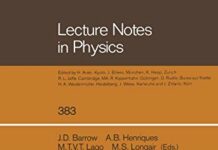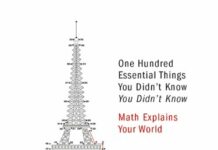
Ebook Info
- Published: 2007
- Number of pages: 273 pages
- Format: PDF
- File Size: 1.73 MB
- Authors: John D. Barrow
Description
Will we ever discover a single scientific theory that tells us everything that has happened, and everything that will happen, on every level in the Universe? The quest for the theory of everything – a single key that unlocks all the secrets of the Universe – is no longer a pipe-dream, but the focus of some of our most exciting research about the structure of the cosmos. But what might such a theory look like? What would it mean? And how close are we to getting there?In New Theories of Everything, John D. Barrow describes the ideas and controversies surrounding the ultimate explanation. Updating his earlier work Theories of Everything with the very latest theories and predictions, he tells of the M-theory of superstrings and multiverses, of speculations about the world as a computer program, and of new ideas of computation and complexity. But this is not solely a book about modern ideas in physics – Barrow also considers and reflects on thephilosophical and cultural consequences of those ideas, and their implications for our own existence in the world.Far from there being a single theory uniquely specifying the constants and forces of nature, the picture today is of a vast landscape of different logically possible laws and constants in many dimensions, of which our own world is but a shadow: a tiny facet of a higher dimensional reality. But this is not to say we should give up in bewilderment: Barrow shows how many rich and illuminating theories and questions arise, and what this may mean for our understanding of our own place in thecosmos.
User’s Reviews
Reviews from Amazon users which were colected at the time this book was published on the website:
⭐Alas, no.Over the years I have read several Barrow books: The Book of Nothing, Impossibility, Pi in the Sky, etc. Maybe even the first edition of this one (I don’t have it, and seem to remember it but very hazily, but that might be a consequence of Barrow’s writing essentialy one book under several titles, an impression of mine probably deriving from the fact that he tackles metaphisically entangled themes such as infinity, being, the nature of reality, TOEs, etc., which in my view are intimately related).”New TOEs” is in my opinion a somewhat obscure and defective book, because (1) the first edition hasn’t been rewritten but addded to; (2) it’s an uneven mixture of dumbing down and illusory depth; and (3) Barrow has, not a golden, but a leaden (or iron, were we to follow Hesiod) pen.(1) NOT REWRITTEN BUT ADDED TO: in page 3 he writes as if the 20th C had still to end; in his first summary of superstrings (“ss”) (p. 24) he doesn’t mention M theory, an omission which he makes good in page 32 ff., but without including the landscape problem: this is fleetingly alluded to only once in the whole book (p. 133), as contrasted to the constant references to eternal inflation and bubble Universes; there’s constant emphasis on the heat death of the Universe whereas the acceleration of expansion (pp. 130/133, oddly introduced as a “rival Theory of (almost) Everything” to ss in p. 129) is treated only once; an unclear graph extends only to 1988 (p. 170); “if ss theory manages to produce some observable prediction in the not too distant future” (p. 224); etc. etc.(2) UNEVEN MIXTURE OF DUMBING DOWN AND ILLUSORY DEPTH. I’ll give just two examples (they take space), although there are many others: in pp. 46/50 Barrow discusses (unnecesarily in my view) the transfinite numbers -by the way there he states, mistakenly, that “the real numbers possess a higher cardinality than the natural numbers and it is denoted by … (aleph-one)”, when actually neither Cantor nor anybody else managed to prove that ‘c’, the power of the continuum, equals aleph-one, which is the cardinal of the first uncountable ordinal-. This is conceptually, for a layman, quite advanced stuff; yet elsewhere in the book he finds it necessary to define angular momentum as the total rotational energy of a body. Now, is it conceivable that a person who doesn’t know what angular momentum is will be at ease and indeed understand four pages on denumerable and non-denumerable cardinals?The other example is in page 228, where we are told that power series expansion and the “implicit function theorem … define … what local information about the world can be deduced from global … information”, and that “Stoke’s famous integral theorem and the process of analytic continuation” are examples of the converse. Now, I know the meaning of these terms because I studied real and complex analysis in college. But a layman? For me, this information is unnecessary; for a layman (I suppose) unintelligible. So, whom is the book adressed to?(3) BARROW HAS, NOT A GOLDEN, BUT A LEADEN (OR IRON, WERE WE TO FOLLOW HESIOD) PEN. Where to begin? At random: in p. 57, speaking of oscillating infinite series, we find the baffling statement “the limiting value of a sum must be specified together with the procedure used to calculate it”.In p. 70 the fall of a rock is described in such a confusing way that I had to spend some time figuring what he must have wanted to say so that the paragraph would not be incorrect.In p. 79 he asserts that “the Newtonian Universe will not tolerate the consideration of an infinite space distributed with matter: this leads to an infinite aggregate of gravitational influences at any one point”: what does he mean by that? does he refer to an isotropic Universe? is it a restatement of the reverse of Olber’s paradox for gravity? Because Newton’s answer was that, as the Universe was infinite and therefore symmetrical (around the Earth, for example) influences cancelled out. Does Barrow mean that in a Newtonian cosmology the Earth would be torn apart by infinite gravitational forces coming from everywhere, from the “space distributed by matter”? Would each one of us be sucked towards the outer limits of the Universe (but not torn apart, because the gradient wouldn’t be as steep as near a black hole’s central singularity?)?In p. 226 what I assume to be Taylor’s power series expansion is described with such an unusual terminology (I mean, “mathematical operation upon an input x” is perfectly acceptable, but why not say “function” when in pp.220/222 he mentions “Riemmanian geometry and tensors”; “Groups”, “Hilbert spaces” and “Complex manifolds”?) and notation that I’m left in doubt as to what he wanted to convey.In p. 227 we learn that “the world is non-local. This is the import of Bell’s famous theorem”. I don’t doubt that Barrow knows what he’s talking about, but that’s not Bell’s theorem. Eddington, he of verily the golden pen, would have put it differently.Well, enough for me. Am I nitpicking? But all this from a tense-challenged (p. 98) mathematician!There’s a fourth point, but that depends on personal tastes: dwelling so extensively on time and its arrow, entropy, thermodynamics and the heat death, etc., I would have liked Barrow to have said something about the problems of recurrence, Bolzano’s worries, Poincaré’s theorem, etc. In the case of Wheeler-DeWitt’s equation and Hartle-Hawking state, I would also have liked something said about loop quantum gravity. Idem about background independence (there’s only one line about it).The book’s strong points are its emphasis on philosophy of math and phy; the clear if brief treatment of Einstein’s cosmological constant; the mention of Xia’s result about Newtonian mechanics (pp. 30/31, interesting because its resulting invalidation parallels GR’s by the prediction of black hole singularities); the apt titles of some section headings: “The eternal golden braid”, “The importance of being constant”, “Goodbye to all that”, etc., which, if really Barrow’s, show culture and a wry sense of humour; the inclusion of all the “sexy” problems in cosmology, with the fourth point caveat and excepting the COBE and WMAP probes (but they really have little to do with the book’s main thrust); and the very moderate space given to M “theory”.For me the book rates three stars, but I learned nothing new, and it wasn’t particularly enjoyable, so one star less for the loss of time.
⭐Barrow’s book is densely packed with information and novel insights, but it’s a slog to get through. The author is repetitive and not always clear, because he relies a lot on the assumption you’ve read his earlier works and are quite literate and up-to-speed on philosphical arcania.Nevertheless, I think you will be rewarded by a careful reading and rereading of this volume. Here Barrow attempts to parse the largest questions about reality and the universe into crisp catagories. In itself this is quite a task and he accomplishes it, though a bit too tersely.Like Penrose’s “The Road to Reality,” Barrow’s “New Theories of Everything” is, in a way, exhaustive and exhausting.But not reading it leaves a wide and unnecessary hole in one’s understanding about modern physics and its implications for the largest questions about our material existence.
⭐If I wasn’t a John D Barrow fan, previously, I would be by now. He has an excellent way of presenting knowledge that fits right inside my learning styles. He leaves me understanding to the point of asking questions, not because I DON’T understand, but because I DO understand and now I have MORE questions.
⭐This book reflects upon the various elements that any Theory of Everything (ToE) would have to reconcile. A ToE is the holy grail of physics, a theory that would unify the various forces to explain the nature of the universe as we experience it. There have been many attempts to achieve a ToE, but it remains elusive. There is the mathematically beautiful and elegant string theory that suffers that one drawback of having no experimental support. There are those who have given up on a ToE in the sense that the term is normally used, suggesting that the desired degree of unification isn’t possible and that the desire to think it must be is just wishful thinking.Probably the most useful piece of information about this book for one considering reading it is its readability. As works of popular science go, it’s more challenging that most (but not as difficult as, for example, Hawking’s “A Brief History of Time.”) [I have little doubt that those who read physics textbooks will find it a walk in the park.] It has few equations, and the mathematics it does present is elementary. However, it does explore quite complicated ideas. The book uses graphics to assist, mostly diagrams, but many of these require thoughtful consideration in their own right.The organization of the book is based on an eightfold way (no relation to the Buddhist eightfold path) – that is, eight ingredients with which a ToE must be consistent. The nine chapters of the book begin with a brief opening chapter that sets up the rest of the book by discussing what a ToE would really explain (“everything” isn’t necessarily the answer in a strict meaning of that word), what the eight components are, how pre-scientific ToE’s operated, as well as introducing the recurring concept of algorithmic compressibility. (The importance of compressibility lies in the idea that in order to make the equations describing the universe more concise it’s necessary that the data describing the universe be “compressible” – i.e. have some underlying order.)After the intro chapter, the eight subsequent chapters are logically arranged into the aforementioned eightfold way. These are: 1.) laws, 2.) initial conditions, 3.) the nature of forces and particles, 4.) the constants of nature, 5.) symmetries and the breaking thereof, 6.) organizing principles, 7.) Bias and selection effects, and 8.) to what extent mathematics is integral to the universe. Some of these elements (e.g. the laws and constants) we are told couldn’t vary by much and allow us to still exist. So, the question addressed in the book isn’t only how can science get to a theory that explains the existence of a stable(-ish) universe, but further one that can support complex and intelligent life. The chapters on symmetry breaking and selection effects are particularly relevant to this discussion.One of the most interesting discussions is the last. Chapter nine, entitled: “Is ‘pi’ really in the sky?” discusses the question of how fundamental mathematics is to the universe. It’s long been a topic of scientific intrigue that there seems to be no particular reason for mathematics to be as effective as it is at describing the way the universe works. The discussion has resulted in a wide range of replies from those who say the success of mathematics is more illusory and limited than it appears to be, to those who believe the universe not only is written in mathematics but is math (see: the work of Max Tegmark.) That is, some say that there are parts of a stable universe that must be orderly enough to be described mathematically and those are the only parts we truly understand as of yet. Others say mathematics is the bedrock of the universe.I enjoyed this book, and found the organizational approach helped a great deal in thinking about the problem. I doubt I grasped everything the author was trying to convey, but it was a book piled high with food for thought for anyone interested in thinking about the nature of the universe. If you’re interested in the grand-scale questions, I’d recommend this book. That said, there are more readable takes on the subject out there if one is looking for light pop science fare.
⭐When I saw the date of the second edition was 2007, I thought about what had happened in the field of physics since then. As it turns out, it was a pretty irrelevant thought, since the author doesn’t seem to have considered this aspect of the topic at all, being more concerned with the underlying philosophical aspects. Nevertheless, those concepts are interesting enough, but I just got the feeling that Barrow might have done a bit more, given how quickly the field is moving.
⭐Scientific book, not for general reading.A class of its own.
⭐Received not in very good state
Keywords
Free Download New Theories of Everything: The Quest for Ultimate Explanation in PDF format
New Theories of Everything: The Quest for Ultimate Explanation PDF Free Download
Download New Theories of Everything: The Quest for Ultimate Explanation 2007 PDF Free
New Theories of Everything: The Quest for Ultimate Explanation 2007 PDF Free Download
Download New Theories of Everything: The Quest for Ultimate Explanation PDF
Free Download Ebook New Theories of Everything: The Quest for Ultimate Explanation



